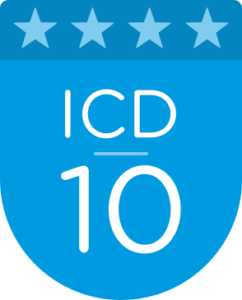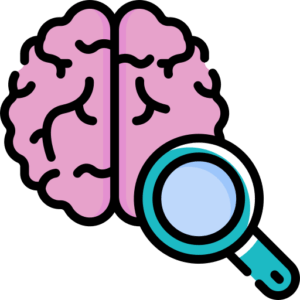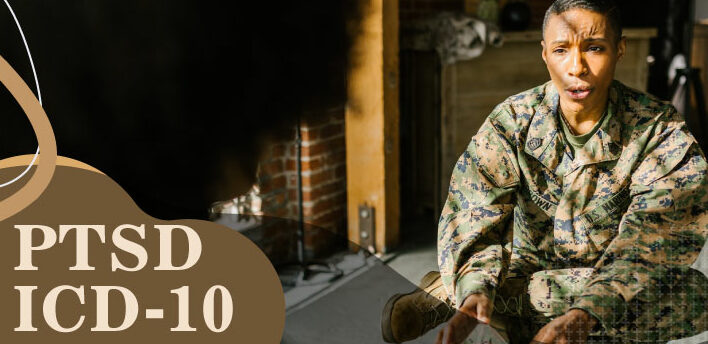Did you know that Post-Traumatic Stress Disorder is classified in the ICD-10 manual? If you are a business owner, it is important to be aware of this classification so that you can provide the best possible care for your employees who may suffer from PTSD. In this blog post, we will discuss what PTSD is, how it is classified in the ICD-10 manual and some of the treatment options available for those affected by this disorder.
Contents
What Is ICD-10?
 ICD is described as the “International Statistical Classification of Diseases and Related Health Problems”. The ICD classifies diseases and injuries, which allows for reliable health statistics globally. The ICD is used by medical practitioners to diagnose patients and by researchers to identify trends and patterns.
ICD is described as the “International Statistical Classification of Diseases and Related Health Problems”. The ICD classifies diseases and injuries, which allows for reliable health statistics globally. The ICD is used by medical practitioners to diagnose patients and by researchers to identify trends and patterns.
Moreover, the ICD is used to track the prevalence of diseases and injuries, as well as to monitor their progress and outcomes. The ICD is also used to assess the effectiveness of health interventions. The most recent version of the ICD is known as ICD-11, which was released in June 2018.
However, PTSD is currently classified under ICD-11, which was released in June 2018. PTSD in ICD-10 is believed to be a reaction to an event that is outside the range of normal human experience. PTSD was first introduced into ICD in 1980, and the most recent revision was made in 2019.
The main changes made in ICD-10 are:
- Addition of different types of exposure to trauma, such as terror attacks, natural disasters, and technological or man-made disasters
- Recognition that not all people who experience trauma will develop PTSD
- Inclusion of children and adolescents in the diagnosis of PTSD
As you can see, there are a few key things to know about PTSD and its ICD-10 classification. Let’s further discuss in detail about PTSD.
What Is PTSD?
PTSD is a mental health condition that can develop after someone experiences or witnesses a traumatic event. It is often described as an anxiety disorder that can cause a person to feel persistent, distressing memories of the event, have nightmares, and experience flashbacks. People with PTSD may also avoid places or people that remind them of the trauma and may feel detached or numb.
This condition is believed to have a strong link to biology and genetics. Research suggests that people with certain genes are more likely to develop PTSD after a trauma.
PTSD was first introduced into the Diagnostic and Statistical Manual of Mental Disorders (DSM) in 1980 and was classified as an anxiety disorder. In 2013, it was reclassified as its own distinct condition in the DSM-V.
PTSD is classified as a “disorder of extreme stress not otherwise specified” in the International Classification of Diseases (ICD), which is used by health insurance companies to diagnose and classify diseases. Some of the common symptoms of PTSD ICD10 include:
- Flashbacks
- Irritability
- Insomnia
- Nightmares
- Avoidant behavior
- Negative changes in mood and thinking
- Feeling disconnected from others
These symptoms can be different and vary in intensity for each person. Some people may experience all of the symptoms while others may only experience a few. PTSD can develop at any age, but it is most common in adults. It is estimated that about three percent of U.S. adults will experience PTSD at some point in their lives. Women are more likely to develop PTSD than men, and people who have experienced multiple traumas are also at a higher risk.
What Are The ICD-10 Codes For PTSD?
 Basically, ICD-10 works like this: there are different codes for different kinds of mental disorders, and each code is made up of a letter and a number. The letter corresponds to the category of disorder, while the number corresponds to the specific type of disorder within that category. So, for example, if someone has PTSD, their ICD-code would be F43.
Basically, ICD-10 works like this: there are different codes for different kinds of mental disorders, and each code is made up of a letter and a number. The letter corresponds to the category of disorder, while the number corresponds to the specific type of disorder within that category. So, for example, if someone has PTSD, their ICD-code would be F43.
PTSD can be classified as: F43.0, F43.21, F43.22 and F43.23 under ICD-10
- F43.0 is for single trauma;
- F43.21 is for repeated or prolonged trauma;
- F43.22 is for post-traumatic stress disorder, acute;
- F43.23 is for post-traumatic stress disorder, chronic.
- PTSD can also be classified as: 309.0, 309.81, and 309.89 under ICD-
- 309.0 is for adjustment disorder with depressed mood;
- 309.81 is for adjustment disorder with mixed anxiety and depressed mood;
- 309.89 is for adjustment disorder with other specified features.
Moreover, the codes of ICD-10 are important not only for mental health professionals but also for insurance companies and government agencies. That’s because these codes are used to track the prevalence of different disorders, as well as to determine how much money should be allocated for research and treatment.
In short, if you or someone you know has PTSD, it’s important to be aware of the ICD code. This code can help to ensure that you get the treatment and support that you need. If you or someone you know is struggling with PTSD, we urge you to reach out for help.
What Is The Role Of ICD-10 In PTSD?
This is a very important question to consider when understanding the ICD- classifications. PTSD, or post-traumatic stress disorder, is a condition that can be classified under several different disorders in ICD-10. The main purpose of ICD-10 is to provide a common language so that health professionals can share patient information across borders.
PTSD ICD-10 is really important because it can help to improve the quality of care for patients. It can also help to ensure that patients receive the best possible treatment. The main role or we could say the aim of ICD-10 in PTSD is to promote better communication and understanding between different health care professionals. Some common benefits of this include:
Enhanced communication
This is one of the benefits of ICD- that can help to improve the quality of care. When different medical staff from around the world are able to share patient information, it helps to ensure that everyone is on the same page. This can prevent misdiagnoses and mistreatment. Communication is the key to establishing the best course of action for each individual patient.
Cost-effectiveness
Another benefit of ICD- is that it can help to reduce the cost of healthcare. When information is shared between different medical professionals, it helps to ensure that unnecessary tests and procedures are not performed. This can save a lot of money and resources. Also, it is believed that ICDs can help to improve the overall efficiency of the healthcare system.
Improved patient care
Patient care is improved when different medical staff is able to communicate effectively. This is because everyone is aware of the latest developments in each case. Also, ICD- can help to ensure that patients receive the best possible treatment. By using a common language, different health professionals can share information and resources more easily. This can lead to better outcomes for patients.
Better data for research purposes
PTSD ICD-10 classification is important to consider when seeking help or trying to understand the condition better. It can provide a lot of insight into how the disorder develops and progresses. Also, the data can be used for research purposes. This can help to improve our understanding of PTSD and develop new and better treatments. ICD-10 is a very important tool that can help to improve the quality of care for patients with PTSD.
The most important thing to remember is that PTSD is not just one disorder. It is a group of disorders that can be classified under several different disorders in ICD classifications. PTSD can range from mild to severe, and it can have a number of different causes. If you think you or someone you know may be suffering from PTSD, it is important to seek help from a qualified mental health professional.
How To Cope With PTSD?
There are a number of ways to cope with PTSD. Some people may find relief in medication, while others may find relief in therapy or support groups. It is important to find what works best for you and stick with it. There are a number of resources available to help you cope with your PTSD. You just need to look out for them. So here are a few tips to cope with PTSD:
Talk to a professional
This is something that you should do if you feel like you are struggling to cope with your PTSD on your own. A professional will be able to help you understand your condition and work with you to develop a coping strategy that works for you. In fact, PTSD is a serious condition that should be treated with the help of a professional. They can guide you with the right kind of therapy and medication.
Talk to a friend or family member
Sometimes, talking to someone who understands what you are going through can be helpful. If you do not feel comfortable talking to a professional, then you can talk to a friend or family member about your PTSD. This will help you feel more supported and understood. You may even find that they have some helpful tips to share with you.
Find a support group
There are many groups out there that can offer support to people with PTSD. These groups can provide an outlet for you to share your experiences and feelings with people who understand what you are going through. This can be a great way to find support and understanding.
Do not bottle up your emotions. It is important to express how you are feeling. If you bottle up your emotions, it can make them worse.
Practice meditation and deep breathing
Meditation is a great way to calm your mind and body. It can help you focus on the present moment and let go of the past. Deep breathing is also a great way to relax your body and mind. This works by slowing down your heart rate and promoting a sense of calm. You can start by doing this for a few minutes each day and then gradually increase the amount of time you do it.
Get active
Exercise is a great way to release some of the tension that you may be feeling. It can also help to improve your mood and give you more energy. It is important to find an activity that you enjoy so that you are more likely to stick with it. You can even try something new like yoga or Tai Chi. The main focus is to get active and release some of the stress that you are feeling. It is so because when you are active you will more likely to feel good about yourself.
Eat a healthy diet
 What you eat can have a big impact on your mood and energy levels. Eating a healthy diet can help to improve your mood and give you more energy. This is because the food you eat provides your body with the nutrients it needs to function properly. Some of the common foods that can help to improve your mood include:
What you eat can have a big impact on your mood and energy levels. Eating a healthy diet can help to improve your mood and give you more energy. This is because the food you eat provides your body with the nutrients it needs to function properly. Some of the common foods that can help to improve your mood include:
- salmon
- nuts
- seeds
- dark chocolate
- avocados
- green leafy vegetables
Get enough sleep
It is important to get enough sleep when you are dealing with PTSD. This is because your body needs time to heal and recover from the trauma. Getting enough sleep can also help to improve your mood and give you more energy. aim to get at least eight hours of sleep each night. In fact, researchers have found that people with PTSD who get a good night’s sleep tend to have fewer symptoms.
Create a routine
Having a daily routine can help to structure your day and give you a sense of purpose. This can be especially helpful if you are struggling to cope with your PTSD. A routine can also help to reduce stress and anxiety levels. Try to stick to a regular sleep schedule and include some time for relaxation or exercise in your day. Overall, you should create a routine to avoid feeling overwhelmed by your PTSD.
Keep a journal
When you are dealing with PTSD, journaling can actually help you a lot. It can be used as an outlet for you to express your thoughts and feelings. You can also use it to track your progress and see how far you have come. Writing in a journal can help to boost your mood and give you a sense of accomplishment. In fact, with this, you can better monitor your PTSD.
PTSD is a serious condition that should not be taken lightly. If you think you may be suffering from PTSD, it is important to seek professional help. There are many resources available to help you cope with your condition. With the right support, you can begin to heal and live a healthy life. Remember, you are not alone in this journey. You just need to look for the help and support that you need.
Conclusion
Conclusively PTSD ICD-10 is a very important classification that you need to know about if you are working in the field of mental health, or if you think you may have PTSD. This blog post has given you a basic introduction to the ICD-10 and how it plays a role in diagnosing PTSD. If you think you may have PTSD, it is important to seek professional help.
For more information, please contact MantraCare. PTSD or Post-Traumatic Stress Disorder is a mental health condition that affects people who have experienced or witnessed a traumatic event. If you have any queries regarding Online PTSD Counseling experienced therapists at MantraCare can help: Book a trial PTSD therapy session


